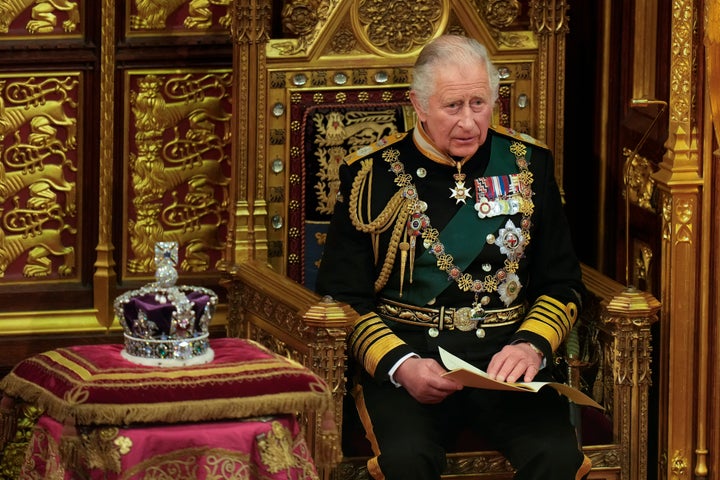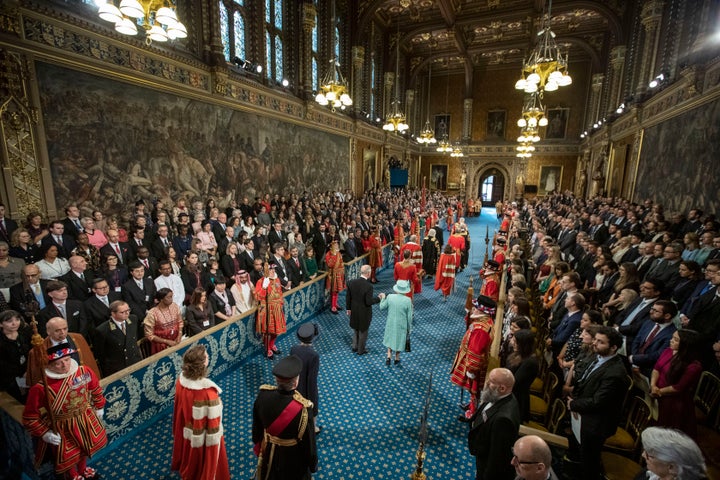
The King’s Speech marks the beginning of a new Parliamentary term and lays out the Government’s plans for the next year or so.
On the surface, this sounds pretty practical and transparent – but the ceremonial occasion is littered with some bizarre traditions which have existed carried out for centuries.
The State Opening itself can be traced back to the late 14th Century, while the delivery of a Sovereign’s speech stems back to the 16th Century.
The current event has been pretty much the same since Westminster reopened in 1852 after a fire in 1834, although the UK hasn’t done the full ceremony in all its full pomp and glory since pre-pandemic 2019.
It’s a pretty big deal – it is the main show of pageantry in Westminster and is the only event which unites Parliament, the Lords and the Sovereign.
While it may be the first time King Charles has delivered the speech as the reigning monarch (although he once stood in for his predecessor, Queen Elizabeth), the first male Sovereign speech since 1950, and Rishi Sunak’s first King’s Speech as Prime Minister, here’s a look at the rather ancient habits which are far from new to the ceremony.
1. The Guy Fawkes effect
Before the monarch arrives at Parliament, the royal bodyguards known as the Yeomen of the Guard ceremonially search the Palace of Westminster’s cellars to check for explosives.
This is something that harks back to 1605 – the “gunpowder plot” orchestrated by Guy Fawkes (and others), when a group of English Catholics tried to blow up the Protestant King James I in a bid for greater representation.
2. MP “ceremonially held hostage”
Yes, following on from the “searching for explosives” stage of the occasion, one MP is ceremonially held hostage in Buckingham Palace while the Sovereign goes to Westminster, to ensure the monarch’s safe return.
It is usually the Vice-Chamberlain of the Household – a title which makes the MP are officially a member of the Royal Household and a Junior Whip for the Government.
Since September 2022, this role has fallen to Jo Churchill, the Tory MP for Bury St. Edmunds.
This harks back to the 17th Century, when King Charles I had a famously difficult relationship with Parliament. He was actually beheaded in 1649 amid the civil war, so perhaps he was right to be worried about his safety.
Don’t worry though – these days, the MP in question will be offered an alcoholic beverage while they watch it unfold on TV.
3. Charles’s special entrance

According to parliament.uk, monarchs traditionally travel to the address in the Irish State Coach, drawn by four horses and preceded by the Imperial State Crown, the Cap of Maintenance and the Sword of State, Charles will arrive in Westminster.
However, the Queen seemed to change tradition when she chose to travel in a car back in 2019 – and Charles followed suit when he filled in for her in 2022.
But this year, he seems to have returned to tradition and rode in the horse-drawn coach.
The monarch will then walk through the Sovereign’s entrance in Westminster, which is based in Victoria Tower – which was, for a time, the tallest tower in the world, standing at an impressive at 98.5 metres.
Charles will then take the steps down the Royal Staircase from the Sovereign’s entrance to Norman Porch – so named because it was meant to house statues of Norman kings – before he begins his processional route in his Imperial State Crown and Robe of State.
According to parliament’s website, this route is the only one the Sovereign can take when they come to the House of Lords.
The Royal Standard flag will be raised in the Palace too, to indicate that the sovereign is present.
4. Officials’ balancing act
The Lord Great Chamberlain and the Earl Marshal walk accompany the monarch to the Chamber, but they’ll have to walk backwards so they don’t turn their backs on the monarch as they carry their “wands” of office.
The Lord Chancellor, who is also the Justice Secretary, will carry a copy of the King’s Speech in a “purse”, too.
5. Doors slamming
In one of the less friendly parts of the ceremony, a House of Lords official called Black Rod will have the doors to the Commons chamber shut in their face.
This harks back to the Civil War era, symbolising how the Commons have been independent of the monarchy ever since.
It also shows how MPs can exclude royal messengers, and honours the events of 1642, the last time a monarch entered the Commons.
King Charles I tried to arrest five MPs for high treason, but the Speaker of the House defied him and told him to honour the privileges of the Commons – meaning he had to leave empty-handed.
Since 2017, Sarah Clarke has been Black Rod, meaning she controls access to and maintaining order in the House and its precincts, as well as within the Lords Chambers. She is expected to participate in all major ceremonial events.
Once the door has been slammed in Black Rod’s face, she’ll have to bang it three times with the rod (there are even marks on this particular door showing its history of being struck, apparently).
6. MPs meant to “talk loudly”
After the three strikes, the doors to the Commons Chamber is opened and Black Rod is permitted to enter. They approach the Table and announce the monarch’s Summons.
MPs following the official to the Lords to hear the speech, and they’re meant to be “talking loudly”. The noise is meant to show they are still independent from the monarchy, even though they are following the senior official to hear the Sovereign.
The MPs usually engage in small talk with their opposite number during this walk to the Lords Chamber – a moment which is prime time for broadcasters to snap some awkward shots of the Prime Minister and the Leader of the Opposition looking uncomfortable and stuck next to each other.

7. MPs barred from crossing a line
There’s only enough space for a few MPs to go into the Lords chamber – but those who do have to stand behind the “Bar of the house”, beyond which guests or visitors cannot pass when the house is at work.
In the Lords, this is marked by a railing while in the Commons it is marked by a white line on the floor.
Once Charles has read the speech “in neutral tones”, both Houses will debate the contents of it and agree an “address in reply to his Majesty’s Gracious Speech”.
Have any traditions been abandoned?
Yes – until 1679, the occasion was followed by a Westminster Abbey mass.
However, this was cancelled because King Charles II was worried about assassination plots.
Monarchs also used to come to Parliament aboard the Royal Barge on the Thames.
According to POLITICO, members of the public also weren’t encouraged to see the proceedings initially, but gradually it became an opportunity for people to see their monarch in real life.
The outlet also reported that Buckingham Palace once stopped plans to reform the ceremony so a politician reads the agenda instead, after Tony Blair’s Labour started to publicly question the tradition in the 1990s.
